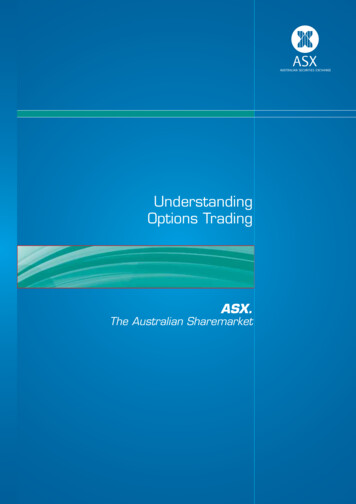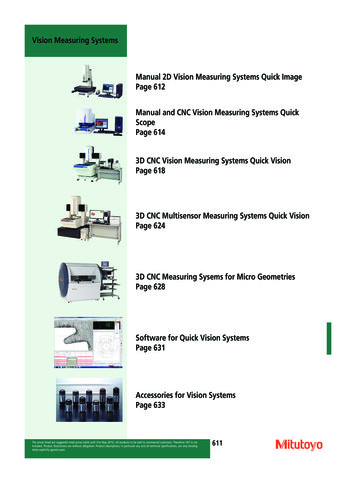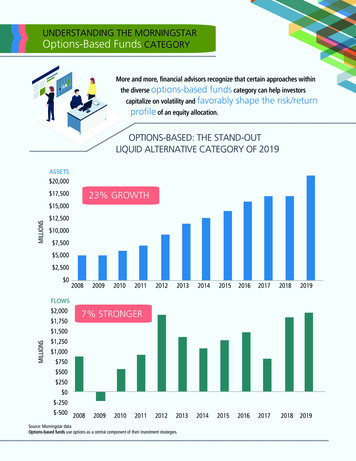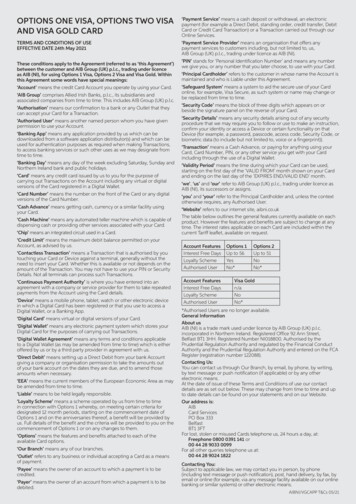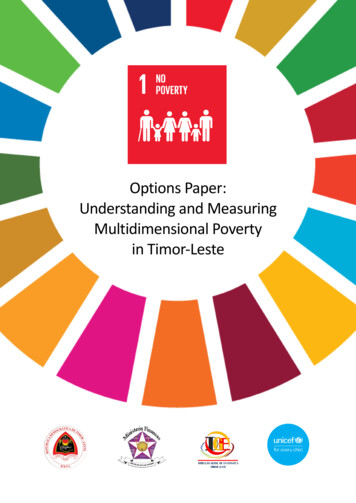
Transcription
Options Paper:Understanding and MeasuringMultidimensional Povertyin Timor-Leste
Options Paper: Understanding and Measuring Multidimensional Poverty in Timor-Leste – July 2021This paper was prepared for the Ministry of Finance’s General Directorate for Statistics (GDS), with supportfrom UNICEF Timor-Leste, by Lucia Ferrone, Ph.D. (lucia.ferrone@gmail.com).November 2021Suggested citation: Timor-Leste Ministry of Finance and UNICEF, Options Paper: Understanding andMeasuring Multidimensional Poverty in Timor-Leste, 20212
Options Paper: Understanding and Measuring Multidimensional Poverty in Timor-Leste – July 2021ContentsExecutive Summary . 5I.Introduction . 6II.Rationale for measuring multidimensional poverty. 6III.Theoretical background . 81.Core elements of Multidimensional Poverty Measurements . 9a)Dimensions . 9b)Indicators. 10c)Thresholds . 11d)Aggregation function . 12e)Weights . 13f)Cut-off(s) . 142.Considerations on data . 15a)Choice of data . 15b)Disaggregation by groups versus constructing multiple measures. 15c)National versus international measures . 16IV.Defining a national MDP measure in Timor-Leste . 191.Process. 192.Options chosen and rationale . 19a)Data choice . 19b)Choice of dimensions and indicators . 21c)Choices on method of aggregation and cut-off . 26Option 1: Nested weights . 26Option 2: Equal weighting . 29Decision on weights and cut-off . 323.V.Further analysis . 32a)Comparison with monetary poverty . 32b)Dimensions of deprivation . 33Conclusions . 35References . 36Annex 1: Thresholds of indicators . 38Annex 2: Weights in the nested weights option . 40Annex 3: Weights in the equal weights option . 41Annex 4: Questionnaire shared with GDS, UNICEF, UNDP, and WB . 42Annex 5: Additional statistics – MDP scores . 433
Options Paper: Understanding and Measuring Multidimensional Poverty in Timor-Leste – July 2021TablesTable 1: Examples of dimensions and age groups . 9Table 2: Example of threshold for a sanitation indicator . 12Table 3: Example of aggregating indicators into dimension . 13Table 4: Examples of aggregation methods and weighting schemes . 14Table 5: Multidimensional Poverty Index (OPHI/UNDP) . 16Table 6: Multidimensional Poverty Measure – World Bank . 17Table 7: UNICEF Global Multidimensional Child Poverty measure . 17Table 8: Topics covered by TLSLS and DHS. 19Table 9: Dimensions, indicators and age groups. 22Table 10: Prevalence of deprivation in each indicator by municipality . 25Table 11: Weighting of dimensions for each group . 27Table 12: Multidimensional poverty by area and municipality - nested weights . 28Table 13: Multidimensional poverty by age group and gender - nested weights . 28Table 14: Indicators' weight with equal weighting . 29Table 15: Multidimensional poverty by area and district - equal weights. 31Table 16: Multidimensional poverty by age group and gender- equal weights . 31Table 17: Multidimensional poverty headcounts by broad age groups - equal weights . 32Table 18: Deprivation in each dimension . 33Table 19: Overlaps in WASH, living standards, and nutrition - children under 6. 344
Options Paper: Understanding and Measuring Multidimensional Poverty in Timor-Leste – July 2021Executive SummarySDG target 1.2 states: “By 2030, reduce at least by half the proportion of men, women and children of all agesliving in poverty in all its dimensions according to national definitions.” This definition specifically calls for anational measure of poverty that goes beyond monetary metrics and can capture the poverty of differentdemographic groups. Constructing a national Multidimensional Poverty (MDP) measure is thereforefundamental to monitor SDG 1.2, as well as to have a complete picture of the conditions of the population.The General Directorate of Statistics (GDS) engaged in a process of reviewing options for the construction ofan MDP measure in Timor-Leste, with support from UNICEF. This included presentations by a UNICEFinternational consultant, discussions of the different methodologies and core elements to measure MDP, anddecisions by GDS about the final elements of the national MDP measure. The leadership of GDS has beencrucial to the successful completion of this work, as well as the involvement of UNICEF, the World Bank,UNDP, and UN Women.This paper is a synthesis of this process. It first reviews and presents the central elements needed to constructa national measure of multidimensional poverty. Different methodologies to construct and aggregateindicators and dimensions are presented, and their features discussed. The second part discusses the choicesmade by GDS regarding data, indicators, dimensions and other aspects.Indicators and dimensions were defined with GDS starting from international standards and always keepingin mind the international comparability. However, the resulting measure is more tailored to nationalcomplexities. The dimensions chosen are WASH (Water and Sanitation), Living Standards, Information (foradolescents and youth), Nutrition (for children under 6 only), Health, Education (for individuals 6 years andolder), Employment (adolescents and youth), and Child Protection (for children under 6) (see table 9 for fulldetails). The resulting measure agreed upon is an individual-based one. Therefore, each age group hasspecific indicators and dimensions. However, the resulting index is aggregated in one final score for the wholepopulation.As for data, the decision taken by GDS was to use the Timor-Leste Survey of Living Standards (TLSLS) of 2014as the base of data. Other data sources were considered: DHS 2016 and the Population and Housing Censusof 2015. The census was quickly discarded as it does not provide enough indicators. TLSLS was preferred toDHS as it can allow to compare multidimensional and monetary poverty.Finally, different options for aggregation of indicators were considered, and the final choice was to adopt anequal weighting approach, and a cut-off of 0.33. The resulting multidimensional poverty headcount is 55%,higher in rural areas (70%) and lower in urban ones (29%). The multidimensional poverty headcount is 54.3%for children 0-17 (55.4% for boys and 53.2% for girls) and 55.6% for adults aged 18 and above (54.2% for men,and 56.5% for women). Young children and older individuals (60 and over) are the groups with the highestrates of MDP, as well as adolescent boys 15-17. Adult women are more likely to be deprived than men, whileboys are more likely to be deprived than girls. Geographically, the municipalities of Ermera and Ainaro havethe highest headcount of deprivation (75% and 68% respectively).5
Options Paper: Understanding and Measuring Multidimensional Poverty in Timor-Leste – July 2021I.IntroductionThis paper’s goal is to provide a theoretical overview and to map options to measure multidimensionalpoverty (MDP) in Timor-Leste, in order to develop a national measure of multidimensional poverty, in linewith SDG target 1.2. Constructing a national measure of MDP requires decisions around the core elementsof MDP including dimensions, indicators, data source, and aggregation method.After reviewing the rationale for measuring multidimensional poverty, the paper provides some theoreticalbackground, including an explanation of key elements common across different methods to measuremultidimensional poverty, as well as considerations on data.The paper then reviews the available options for the Timor-Leste context, including their strong points andweaknesses, and presents the options retained by GDS.The paper was developed through a series of remote meetings between staff from the General Directorateof Statistics (GDS) and UNICEF, and a UNICEF international consultant. Inputs were received from the WorldBank, UNDP and UN Women, which greatly enriched the process.II.Rationale for measuring multidimensional povertyIdentifying, locating, and profiling the poor and deprived individuals in a society are crucial steps todesigning and implementing good policies. Understanding why people are – and remain – poor and why andwhere poverty persists is pivotal in the pursuit of human development.The recognition that poverty encompasses a concept that is broader than monetary metrics has long beenaccepted in both academia and international and national organizations. It follows from the notion thatdevelopment is more than the mere growth of the GDP. The revolutionary work of Amartya Sen (1981; 1990)has broadened our understanding of economic and social progress, and contributed to making the notion ofhuman development a cardinal point of the development agenda.The multidimensional conception of poverty is now well established and has been highlighted in the Agenda2030’s Sustainable Development Goals (SDGs), the Report of the Commission on the Measurement ofEconomic Performance and Social Progress (Stiglitz et al., 2009), and, more recently, by the AtkinsonCommission’s report on Monitoring Global Poverty (World Bank, 2017).Therefore, understanding and monitoring multidimensional poverty is a central point to the success of theFive Ps in the Agenda 2030: People, Planet, Prosperity, Peace, and Participation.Target 1.2 of Goal 1 of the SDGs aims to:“By 2030, reduce at least by half the proportion of men, women and children of all ages living in poverty in allits dimensions according to national definitions.”While defining the target of poverty reduction, SDG 1 explicitly recognizes three fundamental aspects ofpoverty: 1) that it needs to be measured and reduced in all its dimensions, 2) that it needs to take into accountdifferent groups of people affected by poverty: men, women, and children, and 3) that internationalestimates of global poverty need to be complemented by national poverty lines, both monetary andmultidimensional.6
Options Paper: Understanding and Measuring Multidimensional Poverty in Timor-Leste – July 2021The SDGs, therefore, offer the unique opportunity for countries to construct a baseline indicator tomeasure progress in reducing multidimensional poverty, besides monetary poverty, and to do so with ameasure tailored to their specific context.In the 20 years since its independence, Timor-Leste has made substantial progress in several key areas forhuman development, such as child and maternal mortality, undernutrition, access to electricity, etc.However, the recent decrease in national income, coupled with the current COVID-19 pandemic and likelyworld-wide economic slowdown, could slow progress, and even reverse it in some areas. Multidimensionalpoverty is a useful tool to look at the needs of the population in a more holistic way, beyond looking atdifferent indicators separately. Showing the extent of multiple deprivations, it offers a different perspectiveon the well-being of the population and of different groups (e.g., children, women, etc.). It can be a powerfultool for both advocacy and policy.A multidimensional poverty measure can assist in identifying challenges and priorities of interventions. Assuch, it can help design policies and interventions in a more effective way, helping multisectoral analysis. Forexample, a region in which most people are deprived in education and water requires a different strategyfrom an area in which most people are deprived in housing conditions and access to health care. Additionally,using multidimensional poverty to integrate and complement standard monetary poverty assessment can bea powerful way to highlight different needs. For example, some groups or areas may be better served bypolicies to increase their income, while others need other types of interventions to address theirdeprivations. Using multidimensional poverty can also improve the analysis of budgeting allocations, forexample showing if the social expenditures are addressed to the most deprived or not (Jellema et al, 2020).Box 1: Country examples of using MDP measurementsMexico: Using a multidimensional poverty measure to target municipalities in Oaxaca State. Usingmultidimensional poverty analysis, a strategy was developed to fight poverty in 40 top-prioritymunicipalities out of the State of Oaxaca’s 570 municipalities. Interactive maps were created, evenindicating by street the areas with the highest concentration of the population experiencing specificdeprivation, in order to identify the areas of the municipality requiring extra interventions.Vietnam: Using a multidimensional poverty index to redistribute resources to certain regions. The MPIin Vietnam has informed budget allocation decisions, helping to redistribute resources into regions with ahigh proportion of people living in poverty.Cambodia: Multidimensional child poverty guiding annual budget formulation. The launch of amultidimensional child poverty report in 2018 led to the inclusion of multidimensional child poverty in thestrategic results framework of the Rectangular Strategy Phase IV – a key document that guides annualbudget formulation and the prioritization of programmes and activities that contribute to achieving keyresults.Bhutan: Multidimensional poverty as the key criteria for allocation of resources to local governments.As a budgeting tool, the MPI has been used as one of the five criteria for allocation of national resourcesto local government since 2013. A resource allocation formula (RAF) considers multidimensional povertyas a crucial factor by putting 45 per cent weight in its calculations.(UNICEF, 2021)7
Options Paper: Understanding and Measuring Multidimensional Poverty in Timor-Leste – July 2021III.Theoretical backgroundThe multidimensionality of poverty has long been recognized, and both academia and United Nations (UN)agencies have increasingly adopted a multidimensional perspective in analyzing and addressing poverty andwell-being. In the last decade, studies on multidimensional child poverty and deprivation have proliferated.The most relevant theoretical approaches to multidimensional poverty (MDP) are the capabilities, and basicneeds approaches. They have been the first to show the limitations of a purely monetary approach incapturing deprivations (Hicks and Streeten, 1979; Sen, 1998, 1999; Biggeri and Mehrotra, 2011). Empirically,several studies have found that deprivation in several relevant dimensions (for example, health, education,nutrition) often does not overlap with monetary poverty, further demonstrating the limits of the monetaryapproach to fully capturing the conditions of individual or familial deprivation (Laderchi, 1997; Atkinson 2003;Bourguignon and Chakravarty, 2003; Laderchi et al., 2003; Alkire and Santos 2013; Alkire 2014, Burchi et al.,2018; Cuesta, Jellema and Ferrone 2020).The indexes used in the literature to measure well-being and deprivation can be distinguished by thedimensions of well-being used, the subject of the analysis (countries, households, individuals), the weightingof their variables, and aggregation methods (Alkire and Foster, 2011; Alkire 2018).Parallel to the measurement of MDP for the whole population, specific measurements of multidimensionalchild deprivation have been developed and increasingly used in the past decade. Gordon et al. (2003) firstdeveloped a child-specific multidimensional poverty measurement methodology at the request of UNICEF,known as the Bristol Approach. That study measured multidimensional child poverty (MDCP) across 46developing countries, anchoring MDCP to the notion of deprivation of basic human needs and child rightsand defining absolute child poverty as deprivation in at least two out of seven dimensions among food, safedrinking water, sanitation facilities, health, shelter, education, and information. Subsequent studiesoperationalizing the MDCP from the child rights perspective include that of Roelen, Gassmann and deNeubourg (2010) in Vietnam. Building on these studies, UNICEF developed its own MDCP measure based onchild rights in the domains of child survival, development, protection, and participation (Biggeri and Cuesta,2020). The resulting measure, the Multiple Overlapping Deprivation Analysis (MODA), focuses on the typeand number of deprivations experienced simultaneously by each child, rather than on the proportion ofchildren deprived in each dimension, respectively.In multidimensional analyses, the concepts of ‘poverty’ and ‘deprivation’ are often used interchangeably.While traditionally, poverty is firmly linked to some form of monetary measurement, multidimensionalpoverty analyses often simultaneously incorporate monetary and (non-monetary) material deprivationmeasures, composing aggregate indices. However, the concepts refer to different forms of poverty whileoccurring to the same individuals. As argued below, incorporating these different concepts into a singlemeasure and applying this to the entire population denies researchers the possibility of analyzing thecomplex relationships between monetary poverty and other forms of (non-monetary) deprivation.Furthermore, composite indices are mostly based on household level data. This, however, is problematicwhen analyzing the well-being of specific groups, such as children or women, as the needs of people differdepending on their age and as the intra-household resource distribution is not always equal.8
Options Paper: Understanding and Measuring Multidimensional Poverty in Timor-Leste – July 20211. Core elements of Multidimensional Poverty MeasurementsAny MDP measure should include the following core elements: Dimensions: the domains of the measure, such as Health, Education, Nutrition, etc.Indicators with thresholds: indicators are what defines a dimension in practice. They need to have athreshold that defines deprivation. For example, a child is deprived in Education if she does notattend school.Aggregation function: how dimensions and indicators are aggregated into a final measure.Weights: the importance that is given to each dimension and/or indicator.Cut-off(s): similar to a poverty line, a cut-off defines who is multidimensionally poor versus who isnot.In this section, these elements are presented and discussed.a) DimensionsDimensions are fundamental in defining the MDP measure from a more conceptual standpoint. They can becapabilities, or basic needs, or human rights, or defined by a participatory approach. They should reflect thedomains that are important to define deprivation and poverty.The main methodologies and indexes of MDP all define similar dimensions: health, education, nutrition, someform of living standards, access to water, access to sanitation. Dimensions should mostly reflect outcomesrather than inputs. For example, including income or monetary poverty among the dimensions risks beingmisleading, in that it mixes a means with an end.The table shows an example of some of the dimensions that can be defined for different demographic groups.Table 1: Examples of dimensions and age groupsCHILDAccess to educationMANEmploymentWOMANReproductive healthNutritionEducationEducationHealthImproved WASHEmploymentImproved WASHAccess to ICTGender equalityHousingHousingAccess to ICTHousingImproved WASHMultidimensional poverty is concerned by the actual access to goods and services (‘outcomes’) rather thanthe means to acquire them (‘inputs’), such as income. Even when we use a measure of consumption, this islimited by several factors. Consumption captures the ability of people to purchase goods and services at themarket prices. However, heavily subsidized public and/or private goods and services may not be reflected inconsumption. For example, if education is free, access to education will not be reflected in the consumptiondata. Factors that depend heavily on infrastructure, such as access to sanitation and water, will also not bereflected adequately by private consumption. This should therefore be considered when we select9
Options Paper: Understanding and Measuring Multidimensional Poverty in Timor-Leste – July 2021dimensions to complement monetary poverty, and one important consideration is that the dimension shouldreflect the notion of poverty in a given setting.However, there needs to be a balance between information and synthesis. An MDP measure selects the mosteffective proxies to measure deprivation, to avoid doubling information or adding information that is notrelevant. This is crucial in defining an MDP measure, as adding indicators and dimensions has consequenceson the resulting headcount. For example, indicators related to ante-natal care, skilled birth attendance, andpost-natal care, are all important per se. However, they reflect a similar underlying construct, access tomaternal and neonatal care. Therefore, using all three is expanding the measure in a way that is not reallyadding information.Having a theoretical framework is, therefore, useful in guiding the choice of dimensions to include in themeasure. Some studies have used participatory methods to define dimensions of deprivation, i.e., they haveused focus groups and other qualitative methods to define the items of the MDP measure (Main & Bradshaw,2012; UNICEF Uganda, 2019). It is however important to highlight that even when using participatorymethods, many of the dimensions remain the same, or at least very similar. Across contexts, people valuesimilar things for a meaningful life.b) IndicatorsIndicators are how dimensions are operationalized in practice. They will inevitably reflect data availability;however, data availability should not be the sole justification for them.The choice for or against an indicator may change the incidence and the nature of the observeddeprivation. It matters, for example, whether access to education is measured by formal enrolment, byactual attendance or by school attainment (or by a combination of indicators). The choice of indicators iscrucial because it also determines what types of analyses on determinants of deprivation are possible in thelater stages of the research.Some general principles on indicators are that they should:1. Reflect as much as possible the dimension they refer to.2. Not refer to correlates or drivers of deprivation.3. Have a defined and consistent reference population.1) The first point is the most crucial: how indicators for a dimension are defined has a strong impact on theresulting MDP measure. Indicators should be consistent with the dimension they proxy. They should, as muchas possible, reflect aspects of that dimension. If more than one indicator is used, they should be formative,rather than reflective (Maggino, 2014): i.e., they can relate to different aspects of the same underlyingdimension. For example, we can measure deprivation in education by children not going to school and alsoby children being behind in school. The first indicator measures basic access (enrollment), the other gives ameasure of quality (if a child is behind in school, she/he is likely not learning much).2) An important distinction should be made between indicators and what are correlates of deprivation. Livingin a rural area, for example, can make a person or a household more likely to suffer a particular deprivation,but it is not a deprivation in itself. Similarly, having a non-educated mother or parents should not beconsidered a deprivation for a child, but rather a factor in the probability to be deprived.In general, characteristics of a person that cannot be changed such as disability, orphanhood, migrationstatus, etc., should not be treated as deprivation, as they are states of being. Rather, they should be used asfactors to analyze deprivation. A similar argument can be made for input-indicators: how far a child lives fromschool may be used as a proxy for access to education; however, it says nothing about whether the child is10
Options Paper: Understanding and Measuring Multidimensional Poverty in Timor-Leste – July 2021attending school and learning effectively; even children living far from school may be attending and learningdepending on the conditions of (public) transport and the quality of the school.3) It is important to define the reference population of an indicator. Indicators of MDP are substantiallydifferent from aggregate indicators because they need to reflect the deprivation of each individual.One indicator can be a good aggregate indicator at the country level, but not necessarily good as an MDPindicator. For example, consider the common health indicator of “Percentage of children who suffered froma fever in the two weeks before the survey”. As a population indicator, it is a good health indicator: it reflectsthe diffusion of a certain pathology among children in a given time period. However, using this indicator fordeprivation can be complicated.The first thing to consider is if having a fever can, in itself, be a proxy for deprivation in health. If not, can oneconsider not having received any treatment by a medical professional as an indicator of deprivation? Thisindicator has a skewed reference popu
Options Paper: Understanding and Measuring Multidimensional Poverty in Timor-Leste - July 2021 6 I. Introduction This papers goal is to provide a theoretical overview and to map options to measure multidimensional poverty (MDP) in Timor-Leste, in order to develop a national measure of multidimensional poverty, in line with SDG target 1.2.
